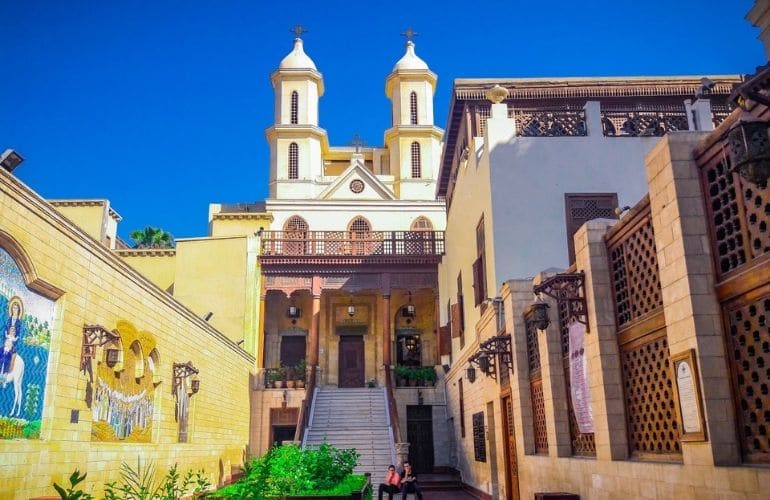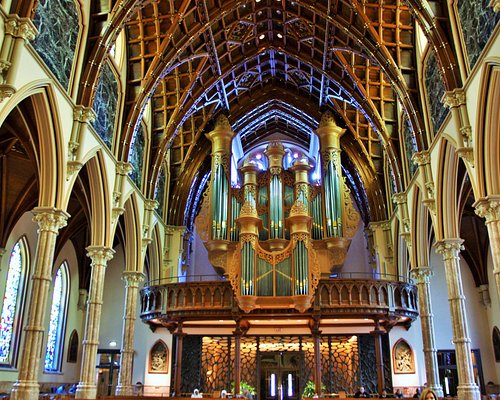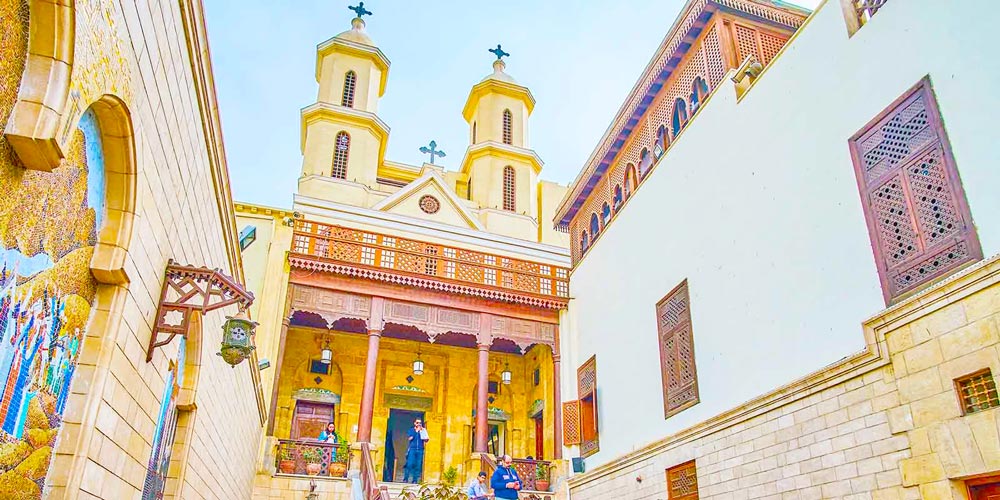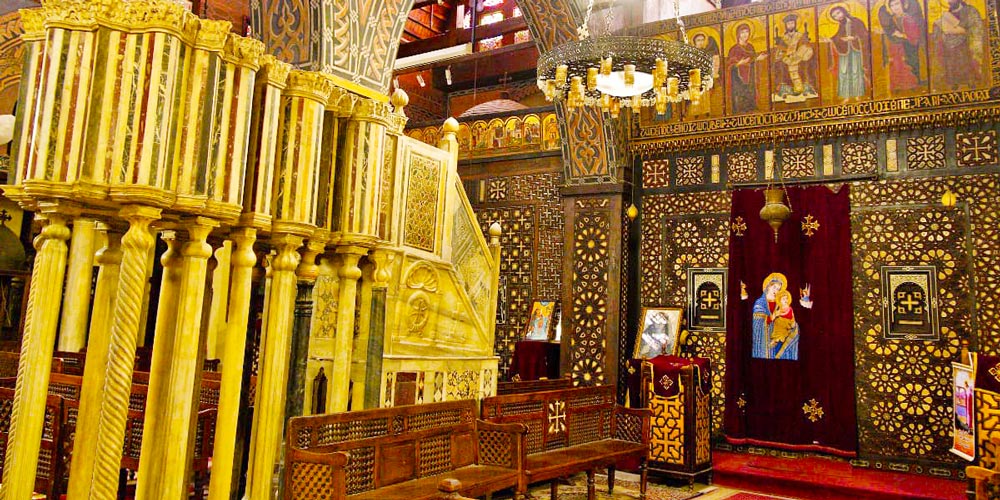A Journey to the Hanging Church: A Spiritual and Cultural Experience
As the oldest Coptic church in Cairo, the Hanging Church is a must-visit destination for anyone interested in Egypt's rich spiritual and cultural heritage. Its unique architecture, intricate design, and fascinating history make it a captivating destination for tourists worldwide. But beyond its beauty and significance, the Hanging Church offers a spiritual journey that touches the heart and soul of everyone inside it.
Join me for a journey to this awe-inspiring place, where we'll explore its secrets, marvel at its beauty, and discover the spiritual and cultural treasures within its walls.

Introduction
Brief Overview of the Hanging Church's historical significance
The Hanging Church, also known as the Church of the Virgin Mary, holds immense historical significance. It is one of the oldest places of Christian worship in Egypt, dating back to the third century. The church gets its name from its unique location, as its nave is suspended over a passageway. This architectural feature gives the church the impression of hanging in mid-air.
Over the years, the Hanging Church has served as a shelter and a place of worship for Christians during various eras and rulers' reigns. It has witnessed significant events, such as the consecration of Coptic Orthodox Popes and the apparition of Mary.
The church is adorned with stunning architectural features, including a ceiling resembling Noah's Ark and a marble pulpit with columns representing Jesus and his disciples. Inside, visitors can admire a collection of iconic paintings, including the famous Coptic Mona Lisa.
The Hanging Church remains an essential site for spiritual and cultural exploration, inviting travellers to delve into its rich history and ambience.

Importance of spiritual and cultural experiences in travel
Regarding travel, getting caught up in the excitement of exploring new landscapes and indulging in different cuisines is easy. However, it's equally important to prioritise spiritual and cultural experiences during your journeys.
These experiences offer a unique insight into a place's history, traditions, and beliefs. They allow us to connect with the local community on a deeper level, fostering a sense of understanding and empathy.
Embarking on a spiritual and cultural journey enables us to broaden our horizons and expand our perspectives. It encourages us to step outside our comfort zones, challenge our preconceived notions, and encourage personal growth. By immersing ourselves in culture's rituals, practices, and stories, we gain a newfound appreciation for the world's diversity.
Furthermore, spiritual and cultural experiences often provide a sense of tranquillity and introspection. Whether walking through the serene halls of an ancient temple or meditating in a sacred space, these moments allow us to reflect and find inner peace. They serve as a reminder of the interconnectedness of humanity and the importance of spiritual well-being.
So, as you plan your next adventure, consider incorporating spiritual and cultural experiences into your itinerary. Seek out historical landmarks, participate in local rituals, and immerse yourself in the destination's traditions. You'll create lasting memories and gain a deeper appreciation for the richness and diversity of our world.

Chapter 1: Discovering the Hanging Church
Background information about the Hanging Church
The Hanging Church, also known as the Church of the Virgin Mary, holds significant historical and cultural importance. Located in the heart of Old Cairo, the church stands on the southern gatehouse of the Roman-built Babylon Fortress. Its name comes from its nave being suspended over a passageway, giving it the impression of hanging in mid-air. This unique architectural design is a sight to behold, especially considering that the ground level was much lower when it was originally built.
The current Hanging Church is believed to date back to the 7th century and has undergone several restorations since then. It has served as a bastion for the Coptic Christian Church, with the Coptic Orthodox Pope residing there since 1047. The church has also been the site of significant religious events, including several apparitions of Mary. It is adorned with 110 marvellous icons representing various biblical figures and has a captivating interior with its vaulted timber ceiling and marble pulpit.
Visiting the Hanging Church provides a glimpse into the rich history of Christianity in Egypt. The courtyard leading to the church is adorned with biblical mosaics, and the three main aisles inside are dedicated to St George, the Virgin Mary, and St John the Baptist. It offers a spiritual ambience that is both awe-inspiring and reflective. If you are looking for a spiritual and cultural experience, the Hanging Church is not to be missed.

Arrival at the site and first impressions
As you step foot on the grounds of the Hanging Church, you are instantly transported to a different time and place. When you arrive at the site, a wave of awe and reverence washes over you. The sheer magnitude of the structure is enough to take your breath away. The church stands tall and proud, its ancient walls weathered by time yet still strong. The intricate details of the exterior architecture, adorned with delicate carvings and stunning mosaics, capture your attention and leave you in awe of past craftsmanship.
The surroundings are serene, with a peaceful courtyard and beautiful gardens, creating a sense of tranquillity that envelops you from the moment you set foot on the grounds. As you take your first steps inside, the dimly lit interior welcomes you with a hushed atmosphere and a palpable sense of spirituality. Rays of sunlight peek through the stained glass windows, casting colourful shadows on the ancient stone floors. The sacred ambience is palpable, and you can't help but feel a deep connection to something greater than yourself. At that moment, you realise this is not just a building; it is a spiritual sanctuary, a place where generations of worshippers have sought solace and peace.
Your first impressions of the Hanging Church are nothing short of awe-inspiring, leaving you eager to explore its rich history and immerse yourself in its spiritual embrace.
Architectural features and unique design of the church
The Hanging Church is not only historically significant, but it also boasts unique architectural features that make it a must-visit destination. Designed in a basilican style of architecture, the church is currently 30 feet above the ground, resting on 15 graceful columns. Its name, the Hanging Church, alludes to its unusual location atop a gatehouse of the Bab al-Futuh during the Fatimid era.
The church's design is a fusion of Roman, Byzantine, and early Islamic architectural elements, giving it a distinctive and captivating appearance. Two towers surround the main entrance, which features a beautifully carved wooden door. A cross-shaped window above the entryway adds to the church's charm, as it occasionally receives sunlight throughout the day.
Once inside, visitors are treated to a breathtaking interior adorned with beautiful carved wood panelling and paintings. The church contains a pulpit suspended from the ceiling and an intricately carved wooden screen separating the nave from the sanctuary. Additionally, the interior is covered with bone and ivory inlaid designs influenced by Islamic art, further enhancing the spiritual ambience.
The architectural features and unique design of the Hanging Church truly make it a gem among Cairo's attractions. Whether you're an architecture enthusiast or simply looking for a spiritual and cultural experience, this church is a must-see destination.

Exploring the interior and its spiritual ambience
Exploring the interior of the Hanging Church is a truly captivating experience. Visitors are immersed in a spiritual ambience that is unmatched.
As you enter the church, you are immediately struck by its unique architectural features and exquisite design. The main aisles of the church lead to three sanctuaries dedicated to St George, the Virgin Mary, and St John the Baptist. Each sanctuary is adorned with elaborate screens inlaid with ebony and ivory, adding to the grandeur of the space.
One of the most remarkable aspects of the Hanging Church is its ceiling, which is constructed of vaulted timber. The design of the ceiling is said to resemble the interior of Noah’s Ark, further adding to the spiritual atmosphere within the church. The marble pulpit, supported by 13 marble columns, is a sight. These columns symbolize Jesus and his 12 disciples, with one depicting Judas’ betrayal and another representing Thomas’ doubt.
The church is also home to a stunning collection of icons, with 110 of them on display. These icons, many of which were painted by a single artist during the 18th century, adorn the sanctuary screens. Among the collection is the oldest and most famous icon, the Coptic Mona Lisa, depicting the Virgin Mary and dating back to the 8th century.
Exploring the interior of the Hanging Church allows visitors to witness its rich history and spirituality. Whether attending a mass or simply admiring the intricate details, it is a truly awe-inspiring experience. So, if you are seeking a spiritual and cultural journey, the Hanging Church is a must-visit destination.

Chapter 2: Historical Significance of the Hanging Church
Historical Context and Foundation of the church
The Hanging Church, also known as the Church of the Virgin Mary, holds a significant place in Egypt's history. It is one of the oldest churches in the country, with its roots tracing back to the 3rd century. The church was initially built as a place of worship for soldiers inhabiting the Roman fortress.
Over the centuries, the church has undergone multiple reconstructions and restorations. The most extensive one took place during the 10th century under Pope Abraham. Since 1047, after the Egyptian capital was moved from Alexandria to Cairo, the church has served as the official residence of the Coptic Orthodox Pope.
The church's historical context is intertwined with the rise and influence of Christianity in Egypt. It has become a symbol of the Coptic Christian faith. Its unique architectural features, such as the suspended nave and the wooden roof shaped like Noah's Ark, add to its allure and spiritual ambience.
Despite facing several preservation challenges over the years, the Hanging Church has remained an important bastion of the Coptic Christian Church. It continues to attract visitors from around the world.

Journey through different eras and rulers' influence on the church
As you embark on a journey through the historical Hanging Church, you will be transported to different eras and witness the influence of various rulers on this sacred place. Dating back to the 7th century, the Hanging Church has witnessed the rise and fall of empires, each leaving its mark on the church's architecture and ambience. From its humble beginnings as a place of worship for Roman soldiers to becoming one of the oldest Christian places of worship in Egypt, the church's historical context is truly fascinating.
Different Christian and Muslim rulers have contributed to the church's development and preservation through the centuries. Under the Coptic Orthodox Pope, the Hanging Church flourished and became the official residence of the Coptic Orthodox Pope. This designation solidified its importance within the Coptic Christian Church and attracted even more worshippers and pilgrims.
One of the most intriguing aspects of the Hanging Church is its role in Christianity and its symbolism. It is known as the site of several apparitions of the Virgin Mary, with one particularly famous story involving a test of faith and a miraculous mountain-moving event. The church's connection to this miracle further cemented its significance within the Christian community.
Throughout its long history, the Hanging Church has faced numerous challenges, including destruction and restoration efforts. Despite these obstacles, the church has managed to preserve its unique architectural features and house significant artefacts and icons. Some of these original artefacts have been relocated to the nearby Coptic Museum, but visitors can still admire the church's stunning interior and listen to ancient Coptic Masses.
Embarking on your spiritual and cultural journey to the Hanging Church and other ancient religious sites is encouraged. Explore the rich history, experience the spiritual ambience, and immerse yourself in the cultural significance of these sacred places. Whether you are a devout believer or simply curious about the world's religious heritage, visiting the Hanging Church is a truly enlightening experience.

Role of the Hanging Church in Christianity and its symbolism
The Hanging Church holds a significant role in the history of Christianity and its symbolism. As one of the oldest places of Christian worship in Egypt, it has become a bastion of the Coptic Christian Church throughout its history. The church is dedicated to the Virgin Mary and contains sanctuaries to her and Saints John the Baptist and George, making it a focal point of devotion.
The Hanging Church is not only a place of spiritual significance, but it also holds immense cultural value. Its unique location, with its nave suspended over a passageway, gives it the impression of hanging in mid-air. This extraordinary architectural design has earned it its name and captivated visitors over the centuries.
The church's interior further adds to its spiritual ambience. Its three main aisles and elaborate screens inlaid with ebony and ivory in the sanctuaries create a sense of reverence and awe. The wooden ceiling, designed to resemble Noah's Ark, and the marble pulpit supported by 13 columns representing Jesus and his disciples are distinct features that add to the church's symbolism.
The Hanging Church has played a crucial role in the Coptic Christian community, hosting significant ceremonies, including selecting and burying patriarchs. It is the site of reported apparitions of the Virgin Mary, further solidifying its importance in the Christian faith. Beyond its religious significance, the church also serves as a cultural treasure, attracting visitors who yearn for a spiritual and cultural experience like no other.

Preservation efforts and challenges faced over the years
Preserving the historical and cultural significance of the Hanging Church has been a priority over the years, but it has not come without its fair share of challenges. The church has experienced several periods of restoration and rebuilding, with the most notable restoration efforts taking place under the 10th-century Pope Abraham. However, despite these efforts, the church's architectural elements have faced wear and tear due to the passage of time and exposure to various elements.
The fusion of Roman, Byzantine, and early Islamic architectural elements within the church's design also presents a unique challenge in terms of preservation. Each architectural style requires specific restoration techniques and materials, which can be costly and time-consuming.
Furthermore, the Hanging Church is a popular tourist attraction, and the influx of visitors can also challenge its preservation. Measures have been put in place to ensure that visitors respect the historical and religious significance of the church, such as limiting access to certain areas and implementing strict rules regarding photography and behaviour.
Despite these challenges, preservation efforts are ongoing, with experts working tirelessly to ensure that the Hanging Church remains a testament to Egypt's rich history and cultural heritage. It is a place that continues to inspire awe and reverence among visitors, and its preservation is vital in maintaining its spiritual and cultural significance for future generations to experience and appreciate.

Encouragement for readers to embark on their own spiritual and cultural journeys
Embarking on a spiritual and cultural journey can be a transformative experience, opening your mind to new perspectives and deepening your understanding of the world. With its rich historical significance and unique architectural features, the Hanging Church provides an ideal starting point for such a journey.
By immersing yourself in the historical context and foundation of the church, you will gain a deeper appreciation for its role in Christianity and the symbolism it holds. As you explore the interior and soak in its spiritual ambience, you will find yourself connecting with something greater than yourself.
But the Hanging Church is just one stop on a much larger journey. Travelling to other sacred sites, such as St. George's Church, St. Mary's Church, and the monasteries of Syrian Baramous and St. Bishoi, will further enrich your spiritual and cultural experience.
Through these journeys, you will learn about different eras and rulers' influence on these sacred places and witness the preservation efforts and challenges faced over the years. This will deepen your appreciation for these sites' historical and cultural heritage.
So, I encourage you to take the leap and embark on your spiritual and cultural journey. Open yourself up to the transformative power of these experiences, and allow yourself to be inspired, enlightened, and enriched. The Hanging Church is just the beginning – a world of spiritual and cultural wonders is waiting to be discovered.
